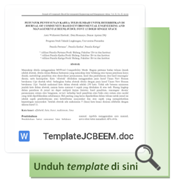DISCRIMINANT ANALYSIS TOWARD DEMOGRAPHIC CHARACTERISTICS OF CIKAOBANDUNG VILLAGE COMMUNITY IN CITARUM HARUM PROGRAM
DOI:
https://doi.org/10.23969/jcbeem.v4i2.3095Keywords:
citarum harum, community participation, discriminant analysisAbstract
The Indonesian Government through the Citarum Harum program formulates steps to control damage and pollution with various indicators of success, including placing the community around the river to behave in an environmentally friendly manner. The results of research on people's behavior intentions in the Citarum Harum program are influenced by various factors, but the demographic characteristics have not been studied whether each category of gender, age, latest education, and monthly income has clear differences in answering the questionnaire statement indicators and which indicators are make a difference. This research was conducted in RW 02, Cikaobandung Village with a discriminant analysis method. The results showed that there were no clear differences in the gender groups and there were clear differences between the group's latest educational characteristics, monthly income and age. Indicators that differ in age groups are IM2, last education is SN1, and monthly income is IM2, PN2 and BI1.Downloads
References
Ajzen, I. (2011). The theory of planned behaviour: Reactions and reflections. Psychology and Health, 26(9), 1113–1127. https://doi.org/10.1080/08870446.2011.613995
Azis, A., & Basuki, I. (2014). Analisa Diskriminan Pada Tingkat Kinerja Pegawai Yang Dipengaruhi Faktor-Faktor Budaya Kerja (Studi Pada Dinas Kebersihan dan Pertamanan Kota Madiun). Epicheirisi, 1, 1–7.
Badan Pusat Statistik. (2018). Statistik Lingkungan Hidup Indonesia (SLHI) 2018. Badan Pusat Statistik, 1–224. https://doi.org/3305001
Bashiru, S. A., & Adekunle, K. (2015). An Overview and Application of Discriminant Analysis in Data Analysis. IOSR Journal of Mathematics, 11(1), 12–15. https://doi.org/10.9790/5728-11151215
Baxter, M. . (1994). Stepwise Discriminant Analysis in Archaeometry: a Critique. Journal of Archaeological Science, 21, 659–666.
Chudzinska, M., & Baralkiewicz, D. (2011). Application of ICP-MS method of determination of 15 elements in honey with chemometric approach for the verification of their authenticity. Food and Chemical Toxicology, 49(11), 2741–2749. https://doi.org/10.1016/j.fct.2011.08.014
Esteban, M., Ferrer, D. M., Vicente, L., Muñoz, A., Claros, F. M., Javier, F., & Ruiz, O. (2020). University as Change Manager of Attitudes towards Environment (The Importance of Environmental Education). Sustainability, 12.
Etherington, T. R. (2019). Mahalanobis distances and ecological niche modelling : correcting a chi-squared probability error. PeerJ, 1–8. https://doi.org/10.7717/peerj.6678
Ghorbani, H. (2019). Mahalnobis Distance and its Application for Detecting Multivariate Outliers. Ser. Math. Inform, 34(3), 583–595.
Ghozali, I. (2016). Aplikasi Analisis Multivariate Dengan Program IBM SPSS 23 (8 ed.). Badan Penerbit Universitas Diponegoro.
Hadining, A. F., Sari, G. L., & Sudarjat, H. (2020). Analisis Faktor yang Mempengaruhi Perilaku Masyarakat untuk Berpartisipasi dalam Program Citarum Harum. Al-Ard : Jurnal Teknik Lingkungan, 5(2), 70–79.
Kamil, R. (2019). Rencana Aksi Pengendalian Pencemaran dan Kerusakan DAS CItarum. Pemerintah Provinsi Jawa Barat.
Li, X., Deng, S., Li, L., & Jiang, Y. (2019). Outlier Detection Based on Robust Mahalanobis Distance and Its Application. Open Journal Statistic, 9, 15–26. https://doi.org/10.4236/ojs.2019.91002
Louppis, A. P., Karabagias, I. K., & Papastephanou, C. (2019). Two-Way Characterization of Beekeepers ’ Honey According to Botanical Origin on the Basis of Mineral Content Analysis Using ICP-OES Implemented with Multiple Chemometric Tools. Foods, 1–13.
Marino, Dewi, Y. S., & Banyuwnagi, D. P. (2014). Perbandingan Analisis Diskriminan Linier, Diskriminan Linier Robust dan Regresi Logistik Biner. Prosiding Seminar Nasional Matematika, Universitas Jember, November, 192–200.
Prinajati, P. D. (2019). Kualitas Air Waduk Jatiluhur Di Purwakarta Terhadap Pengaruh Keramba Jaring Apung. Journal of Community Based Environmental Engineering and Management, 3(2), 78. https://doi.org/10.23969/jcbeem.v3i2.1838
Rahman, F., & Sari, D. P. (2018). Penerapan Discriminant Analysis Untuk Mengetahui Faktor Yang Mempengaruhi Tingkat Kepuasan Pengguna Jasa Unit Layanan PPNS. Seminar Master PPNS, 1509, 51–54.
Santos, S., & Gonçalves, H. M. (2019). Multichannel consumer behaviors in the mobile environment : Using fsQCA and discriminant analysis to understand webrooming motivations. Journal of Business Research, 101(December 2018), 757–766. https://doi.org/10.1016/j.jbusres.2018.12.069
Sari, G. L., Hadining, A. F., & Sudarjat, H. (2020). Analisis Karakteristik Fisik-Kimiawi Air Daerah Aliran Sungai Citarum Di Waduk Jatiluhur. Jukung (Jurnal Teknik Lingkungan), 6(1), 1–9. https://doi.org/10.20527/jukung.v6i1.8232
Supartini, I. A. M., Sukarsa, I. K. G., & Srinadi, I. G. A. M. (2017). Analisis Diskriminan Pada Klasifikasi Desa Di Kabupaten Tabanan Menggunakan Metode K-Fold. E-Jurnal Matematika, 106–115. https://doi.org/10.24843/MTK.2017.v06.i02.p154


















 IN COLLABORATION WITH:
IN COLLABORATION WITH: 
